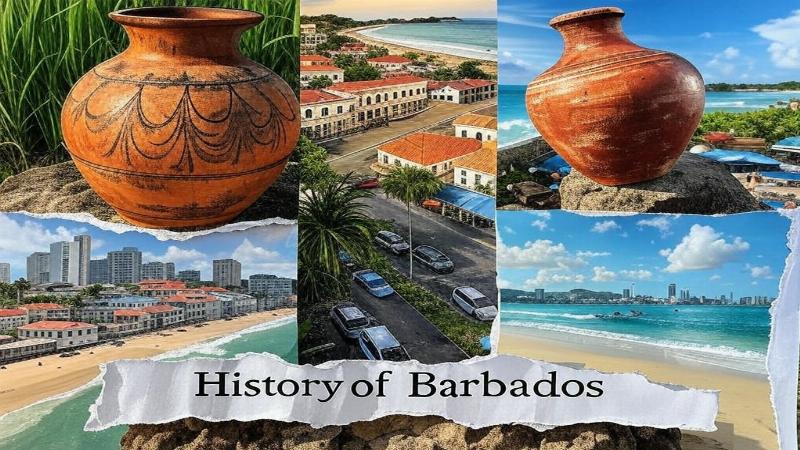Place for ads

Barbados, a small island nation in the eastern Caribbean, is a tropical haven where history unfolds as vividly as its azure seas. Covering just 432 square kilometers, it sits east of the Windward Islands, known today for its beaches, rum, and vibrant culture. Yet, beneath its sunlit charm lies a past shaped by indigenous peoples, colonial powers, and a resilient struggle for identity. From its earliest settlers to its modern role as a tourism powerhouse, Barbados’ history is a compelling tale of adaptation and triumph. In this article, we’ll explore Barbados’ journey through time, uncovering the milestones that define this “Little England” of the Caribbean.
Barbados’ human story begins around 1623 BCE, when Amerindian groups—likely Saladoid-Barrancoid peoples—arrived from South America. Crossing the sea in canoes, they settled the island, leaving pottery and tools unearthed at sites like Chancery Lane. By 800 CE, the Arawak people dominated, farming cassava, fishing, and crafting intricate shell jewelry.
Around 1200 CE, the Caribs—known for their warrior culture—displaced the Arawaks, though their tenure was brief. When Europeans arrived, Barbados appeared deserted, possibly due to Carib raids or migration. These early inhabitants left scant traces, but their legacy hints at a
Place for ads
Portuguese explorers, possibly led by Pedro a Campos, sighted Barbados in 1536, naming it “Los Barbados” (The Bearded Ones) for its fig trees’ hanging roots. They didn’t settle, using it only as a stopover en route to Brazil. Spain, too, bypassed the island, finding no gold or silver to exploit.
For nearly a century, Barbados remained a quiet outpost, visited by sailors but unclaimed. Its isolation ended in 1625, when English captain John Powell landed, planting Britain’s flag and setting the stage for a colonial era that would define the island’s destiny.
In 1627, the English established a permanent settlement under Sir William Courteen, with 80 settlers landing at Holetown. Initially, they grew tobacco and cotton, but poor yields shifted focus. By the 1640s, the “Sugar Revolution” took hold—Dutch traders introduced sugarcane from Brazil, transforming Barbados into a plantation economy.
Sugar demanded labor, and by 1650, enslaved Africans were forcibly brought in, rising from a few hundred to over 50,000 by 1700—outnumbering whites 3 to 1. Bridgetown, the capital, grew into a bustling port, its Georgian architecture reflecting British wealth. Barbados became Britain’s richest Caribbean colony, dubbed “Little England” for its loyalty.
The sugar boom rested on slavery’s horrors. Enslaved Africans toiled in brutal conditions—cutting cane, boiling syrup—under a system codified by the 1661 Slave Code, one of the harshest in the Americas. Families were split, punishments severe, and life expectancy short.
Resistance flared despite the risks. The 1675 slave rebellion saw dozens executed, while the 1816 Bussa Rebellion—led by an enslaved man, Bussa—shook the island, burning plantations before its brutal suppression. These uprisings, though crushed, sowed seeds for change, pressuring Britain toward abolition.
Slavery ended on August 1, 1834, with Britain’s Emancipation Act, freeing over 83,000 Barbadians. An apprenticeship period lasted until 1838, easing planters into wage labor. Freed people built villages like Rock Hall—Caribbean’s first free Black community—farming small plots or fishing.
The sugar economy declined by the 19th century, hit by falling prices and soil exhaustion. Barbados turned to education—schools multiplied under Governor Sir John Pope Hennessy—and trade unions emerged. Yet, poverty lingered, with white elites retaining land and power, fueling social tensions.
The early 20th century saw Barbados stir. The 1937 riots—sparked by Clement Payne’s labor activism—killed 14, forcing reforms like universal suffrage in 1950. Grantley Adams, founder of the Barbados Labour Party (BLP), became premier in 1954, pushing for autonomy within the West Indies Federation (1958–1962).
The Federation’s collapse left Barbados to chart its own course. Errol Barrow, leading the Democratic Labour Party (DLP), took the helm in 1961, advocating full independence. On November 30, 1966, Barbados became a sovereign nation, with Barrow as its first prime minister, keeping Queen Elizabeth II as monarch.
Independence brought pride but challenges. Barrow’s vision—education, healthcare—laid foundations, with free schooling by 1962 boosting literacy to 99%. Sugar waned, and tourism rose—resorts sprouted along the Platinum Coast, drawing Americans and Brits. Bridgetown’s Garrison became a UNESCO site, reflecting colonial roots.
Political stability held, with BLP and DLP alternating power—Tom Adams (1976–1985) and Owen Arthur (1994–2008) shaped growth. The 1980s drug trade posed risks, but Barbados avoided the instability of neighbors. In 2021, it became a republic, replacing the monarchy with President Sandra Mason.
Today, Barbados’ 287,000 people thrive on tourism—over 1 million visitors yearly—and offshore finance. Crop Over, a festival from slavery days, celebrates with calypso and costumes. Climate change—hurricanes like Ivan (2004)—and economic diversification test resilience, but “Bim” pride endures.
Rihanna, born in 1988, became a global icon, named a National Hero in 2021. Barbados balances its past—sugar, slavery—with a future of sustainability and culture, a Caribbean leader in education and living standards.
Barbados’ history is a vibrant mosaic—from Arawak canoes to sugar’s rise, slavery’s scars to independence’s bloom. Its people have turned a tiny isle into a beacon of strength and spirit. As Barbados faces tomorrow, its past shines as brightly as its sun.
Place for ads